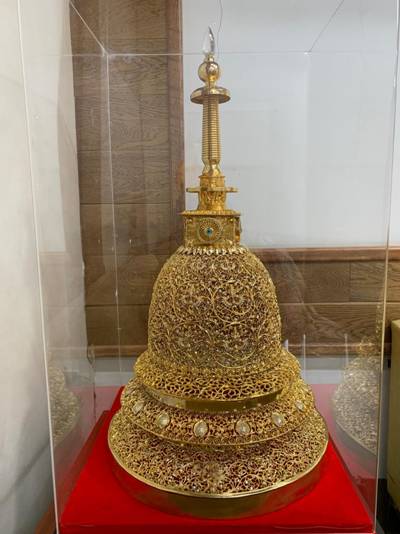The sacred relics of Lord Buddha, currently enshrined at the National Museum in New Delhi, will be taken to Russia’s Kalmykia Republic for an international exposition from October 11 to 18, 2025. The exhibition will be held in the capital city of Elista and marks the first such exposition of the holy relics in the region.
The relics will be enshrined at the Geden Sheddup Choikorling Monastery, also known as the “Golden Abode of Shakyamuni Buddha,” the largest Buddhist monastery in Europe. The initiative is being organised by the Ministry of Culture in collaboration with the International Buddhist Confederation (IBC), the National Museum, and the Indira Gandhi National Centre for the Arts (IGNCA).
A high-level Indian delegation, including 11 senior monks and led by Uttar Pradesh Deputy Chief Minister Keshav Prasad Maurya, will accompany the relics. The delegation will conduct religious services, teachings, and discourses for the predominantly Buddhist population of Kalmykia.
The sacred relics will be received in Elista by the Head of the Buddhists of Kalmykia, Shajin Lama Geshe Tenzin Choidak, and Mr. Batu Sergeyevich Khasikov, Head of the Republic of Kalmykia, along with other senior members of the Buddhist Sangha.
The programme will feature a discourse by His Holiness the 43rd Sakya Trizin Rinpoche, Head of the Sakya Order, and the ceremonial presentation of the ‘Kanjur’—a revered collection of 108 volumes of Mongolian religious texts translated from Tibetan—by the IBC to nine Buddhist institutes and a university.
A Memorandum of Understanding (MoU) is expected to be signed between the Central Spiritual Administration of Buddhists in Russia and the IBC during the week-long event.
The exposition will also include a unique exhibition of Buddhist stamps curated by philatelist Vinod Kumar from Dharwad, Karnataka, showcasing Buddhist themes from over 90 countries.
Another highlight is the IBC’s exhibition titled “Sacred Legacy of the Shakyas: Excavation and Exposition of Buddha’s Relics,” which traces the journey of the Buddha’s relics from their enshrinement to their rediscovery. The exhibition features detailed panels highlighting the sacred geography of the Buddha’s life and teachings, with a special focus on Piprahwa in Uttar Pradesh, identified as ancient Kapilavastu.
Also on display will be an exhibition titled ‘Bodhicitta: Treasures of Buddhist Art’ featuring rare artefacts from the National Museum and the National Mission for Manuscripts, offering visitors a glimpse into India’s rich Buddhist artistic heritage spanning over two millennia.
The sacred relics will be transported from New Delhi to Kalmykia with full religious sanctity, accompanied by senior monks, via a special Indian Air Force aircraft.
Kalmykia, located in southwestern Russia near the Caspian Sea, is home to Europe’s only indigenous Buddhist population. The region is inhabited by the Kalmyks—descendants of Oirat Mongols—who migrated from western Mongolia in the 17th century and have preserved Mahayana Buddhist traditions.
The event follows recent international expositions of Buddha’s relics. In 2022, the Piprahwa relics were taken to Mongolia; in 2024, relics from Sanchi were exhibited in Thailand; and earlier in 2025, relics from Sarnath were displayed in Vietnam.
In July, Prime Minister Narendra Modi welcomed the repatriation of the sacred Jewel Relics associated with the Piprahwa stupa, terming it a proud moment for India and a reaffirmation of the country’s deep-rooted connection with Lord Buddha and his teachings.
The Piprahwa relics were originally excavated in 1898 by British archaeologist William Claxton Peppe in Basti district, Uttar Pradesh, and later studied further by Indian archaeologists in the 1970s. Based on those findings, the Archaeological Survey of India has identified Piprahwa as the site of ancient Kapilavastu, the capital of the Shakya clan to which the Buddha belonged.














